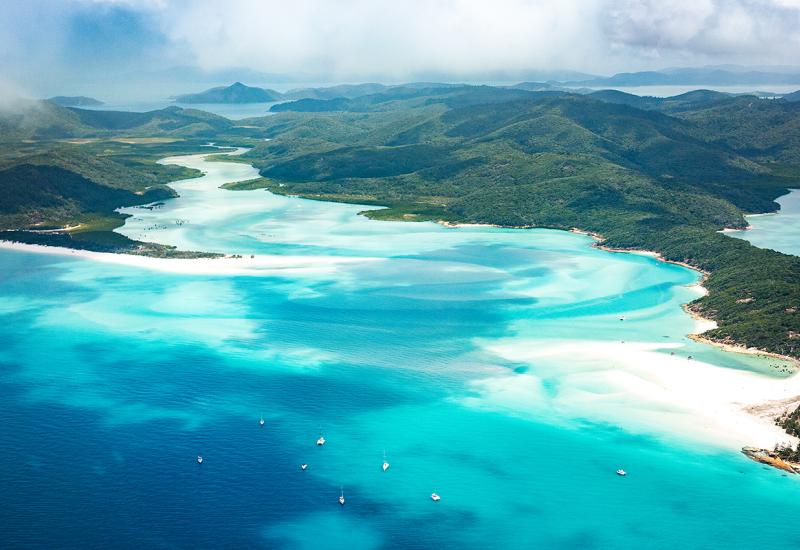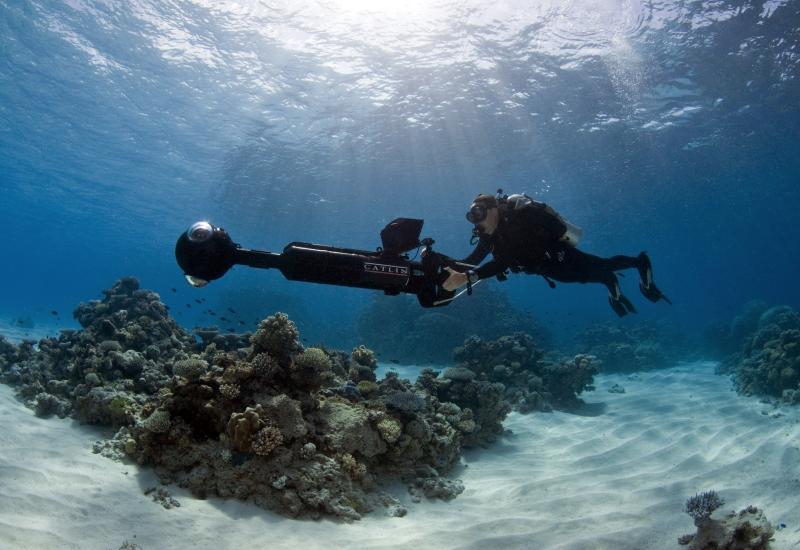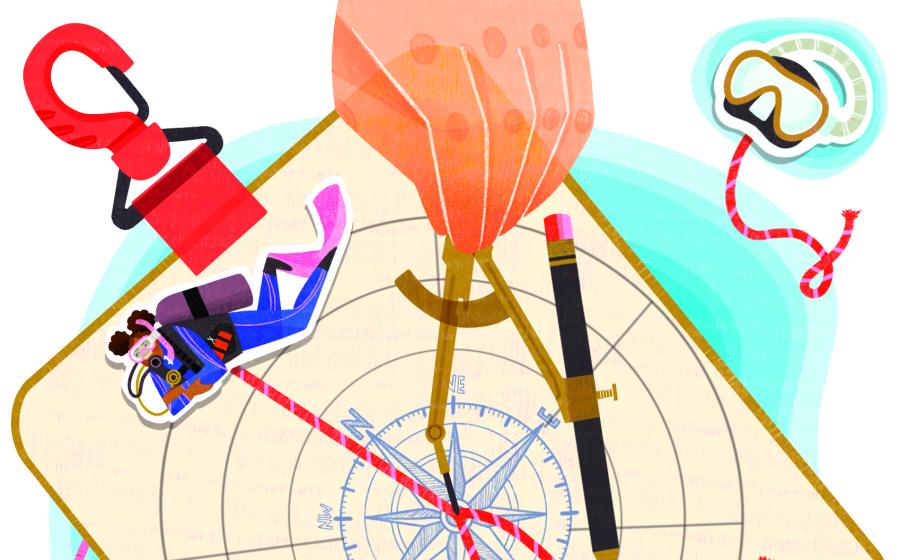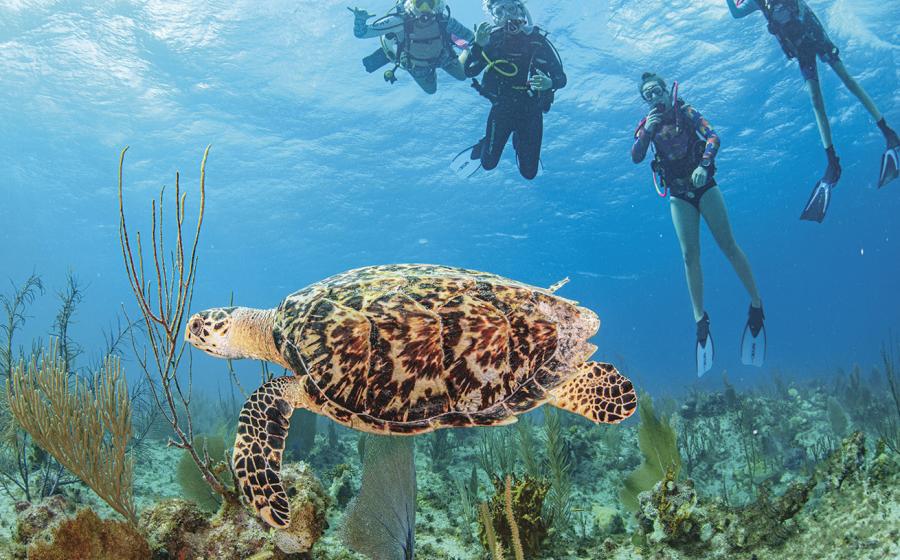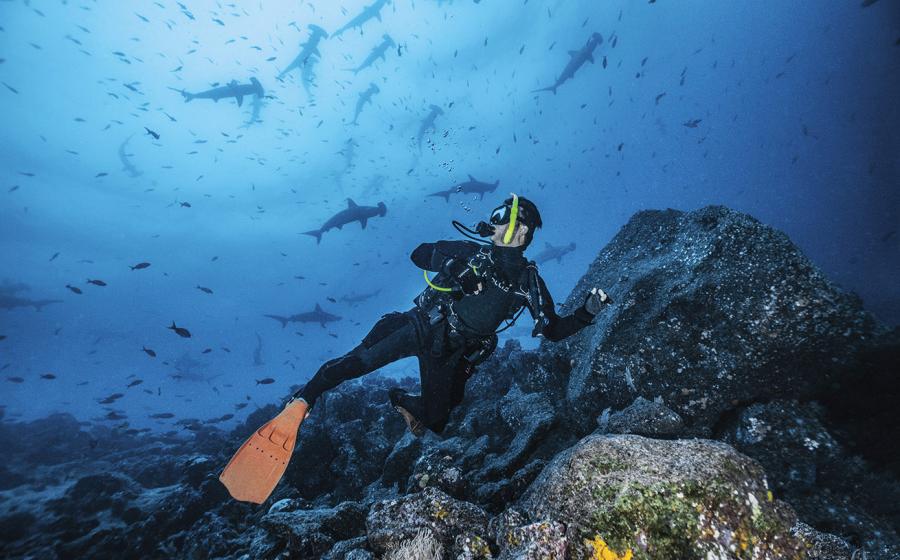Sister Islands: Two for One Dive Trips

Macduff Everton/National Geographic Creative/CorbisViti Levu, Fiji Main island Viti Levu is home to the international airport and offers access to the famed Black Magic Mountain.

Francesca DiacoVanua Levu Coralscape
Less-visited Vanua Levu offers a garden of soft corals.

Jonathan Bird / Seapics.comHorse-Eye Jacks Schooling horse-eye jacks are common in the Turks and Caicos.

Stephen Frink Collection/AlamyHMS Endymion The remains of the HMS Endymion sit in around 40 feet of water and easily accessible by divers.

Ethan Daniels/ Seapics.comHumpback Whales

Francesca DiacoRoatan Reef Purple tube sponges decorate a Roatan Reef.

Greg LecoeurTrumpetfish A juvenile trumpetfish uses camouflage to hide in a gorgonian sea fan.

Julian CohenFiji Reefs Busy reefs from below and above.

Mark Conlin/VWPicsReefs from Above The reefs as seen from above.

Mark StricklandBlacktip Reef Shark A blacktip reef shark visits the famed Beqa Lagoon shark dive.

Alex MustardM/V Capt. Keith Tibbetts

JENNIFER PENNERGoliath Grouper Friendly goliath grouper on Little Cayman love divers almost as much as divers love them.

Shawn HeinrichsMantas in the Shallows Mantas parade along the dramatic coastline of Nusa Penida, feeding on plankton in the shallows.

Doug Perrine/SeapicsFalse clown anemonefish

Ludovic Galko-RundgrenReefs in Bali Busy reefs swarming with anthias are common sights in Bali.
When it comes to an island dive itinerary, visiting one is nice — but seeing two is better. In many island countries, the main destination offers convenience and comfort. Head farther out, and you’ll likely forgo that morning cappuccino, but you’ll be rewarded with wilder diving; perhaps the reefs are more pristine, the muck critters more bizarre or the pelagics more impressive. Just how much so? Read on.
1. TURKS & CAICOS
PROVO
The Diving
If you’re a numbers person, start with this one: 6,000. It’s the depth in feet where the wall bottoms out off Providenciales, aka Provo, the Turks and Caicos’ main island. Here’s another: 100 — as in average feet of visibility on any given dive.
Do the math on Provo’s northwest point at sites like the Crack, named for the fissure that starts at 55 feet and shoots you out into the blue at 80. Once out, you’ll float over the drop-off, which Alan Jardine, owner of Dive Provo, says is “like diving out over a blue line.” You’ll also likely become slightly disoriented by the visibility, so gin-clear as to be a potential liability.
“Before the dive, I remind people of a big anemone at 80 feet; otherwise, they could easily keep going to 120 feet before they know it,” says Jardine.
You’ll also experience the wall off West Caicos, an island southwest of Provo. There, a top site is the Gully, where divers regularly see Sully, the resident Caribbean reef shark.
“Last week, we lost our dive plan completely,” says Jardine. “Three sharks were swimming around us the whole time. People wouldn’t leave the sharks, but there really wasn’t a need to take them further.”
Says Jardine, “Most of our diving is done in marine parks where the grouper and snapper that would otherwise end up on dinner plates are still in the water, smiling at you and your camera.”
The Vibe
Provo is the biggest, most developed island in Turks and Caicos, and many visitors travel no farther, lured by delights like Grace Bay Beach, one of the cleanest, whitest stretches of sand in the Caribbean. It’s developed, but not overly so.
“Grace Bay isn’t smothered by high-rise hotels,” says Jardine. “It’s still a great beach for walking at low tide — there’s so much soft sand, and the sunlight’s not blocked by buildings.”
The island is also popular for restaurants and night life, from local joints like Da Conch Shack to the upscale Coco Bistro, serving dishes such as rack of lamb with goat-cheese scalloped potatoes. diveprovo.com
GRAND TURK
The Diving
It’s ironic: The wall off Grand Turk lies a mere 300 yards from shore, slicing boat rides to sites to as little as three minutes — as opposed to Provo’s average of almost an hour. You’ll return to shore quicker, but the island is so sleepy, there’s not much to do beyond diving.
Luckily, the underwater tours are as thrilling as any zip line, jet ski or banana-boat ride. Most Grand Turk divemasters agree that the best area to start is the island’s northern end, where the healthiest acres of soft corals are blooming at sites such as Black Forest, Alpine Meadow, McDonald’s and Gorgonian Wall.
Here, too, the viz is so good that you’ll get that pleasurable stomach flip when you kick out from the wall.
“The viz is so excellent that when you see the reef disappearing below you, it takes your breath away,” says Vicky Dunsten, activities coordinator for Blue Water Divers, a scuba center on Grand Turk.
She also says that encounters with big animals aren’t common, but when you do see an eagle ray, bottlenose dolphin or, in the winter months, a humpback whale, it’s spectacular. Granted, no operator will take you specifi- cally to swim on scuba with the whales, but if a giant approaches you, that’s acceptable.
Says Dunsten, “If they choose to come near you, there’s not much you can do — it’s not like you have to look the other way.”
The Vibe
“We still have donkeys and cattle roaming the streets,” says Ginny Allan when asked about the pace of Cockburn Town, the main community on Grand Turk. The manager of Bohio Dive Resort adds, “This island has the feel of the Caribbean from 20 years ago, with its rake-and-scrape music.” She’s quick to point out that as much as the destination offers that sleepy, relaxing feel, it’s not without fine wine and dining.
And, if you find afternoons on the beach too quiet for your liking, you can always book another dive. grandturkscuba.com; bohioresort.com
2. HONDURAS' BAY ISLANDS
ROATAN
The Diving
It might be when you’re 75 feet deep on a wall like Mary’s Place, just minutes after finishing breakfast at Barefoot Cay Resort, that you appreciate Roatan’s appeal: high-drama walls minutes from shore.
Roatan, a skinny, lettuce-sea-slug-shaped island running southwest to northeast, offers a variety of diving — but the walls are sheerest on the south side.
“Definitely, Mary’s Place is the best-known site on island,” says Mel James, one of the managers of the resort. “You dive a really deep crevice that’s all coral encrusted, and then you’ll likely see a seahorse in the shallower gardens of sponges.”
When diving any wall, be it Newman’s or Coco View, it’s like gaining a second dip without changing tanks as you ascend to shallower waters. You’ll likely spend the first half of your dive wowed by the depths, the visual impact of the wall and the visibility so clear it’s dizzying; then, you’ll narrow your focus to find the small, weird and wonderful. Just as Roatan is a hotbed of colorful ex- pat characters topside, so it is below: Seahorses, toadfish and frogfish are as common as coconuts.
The Vibe
To get a taste of island night life, try the West End, where some of the biggest happenings are at the open-air bars, juice stands and public beaches on Friday nights. Head farther west to Roatan’s tip, and you’ll find West Bay Beach — the place to be on Sunday afternoons. The island-style excitement starts with hermit crab races and culminates with fire dancers, performing shortly after the applause for sunset ends. barefootcay.com
UTILA
The Diving
If you need a reason to book an onward flight to Utila, here are three: a seasonal whale shark population, a collection of underwater seamounts, and nightlife fueled by an unending stream of backpacking, bright-eyed dive-instructor hopefuls.
The biggest in-water thrill here is the 40-foot whale sharks that appear every March and April. With several on-island research organizations focusing on the species, you’ll learn how to identify individuals and where tagged animals are traveling from.
If it’s not spring, fret not. You’ll still find an adrenaline rush. Head for the hills — Black Hills. This seamount lies in open ocean, rising to within 45 feet of the surface. Because of its location amid depths that plummet to 2,000 feet, it attracts swarms of fish look- ing for structure.
“There’s no surface buoy, so not a lot of people go there unless they know exactly where it’s at,” says Rebecca Engel, co-owner of Utila Lodge.
Engel regularly encounters sharks and schooling jacks at Black Hills. And recently, dolphins. “We heard them before we saw them,” she says. “But when you’re not expecting to see something like that and you encounter one of the most loved mammals, it’s such a special, breathtaking moment.”
The Vibe
You’ll need a rental car on Roatan to see the sights; on Utila, just flip-flops.
“Utila Town is snug,” says Engel of the island’s one community where all bars, restaurants and coffee shops are shoulder to shoulder along the waterfront. “Everything is close to everything — with only one main street, it takes just 15 minutes to walk through the whole town.”
The small-town vibe extends to the welcome you’ll get if you chat up those who grew up here.
Says Engel, “If you go out and meet people, odds are they’ll offer to take you to Pumpkin Hill to watch the sunset or to the freshwater caves.” utilalodge.com
3. FIJI
VITI LEVU
The Diving
You can’t possibly prepare yourself for the sight of Fiji’s soft corals. So says Simon Doughty, PADI instructor certifier with Volivoli Resort, a beach and scuba-centric getaway located roughly midway along the northern coast of Viti Levu, the main island.
“We’ve had marine biologists, underwater photographers and dive journalists come out of the water, and they’re blown away — they have this look on their faces, and they can’t stop talking,” he says.
As for the best sites, find them clustered in two areas, both to the northwest of Volivoli: the Bligh Water and Vatu-i-Ra. Many of the sites are pinnacles starting at 15 feet and dropping in excess of 1,000 feet.
“The reefs are jam-packed with corals, and the farther you drop down, the bigger they get until you see huge ones the size of cars,” says Doughty.
One top spot to drop in is Black Magic Mountain, where the soft-coral action starts just 10 feet from the surface. Descend, and the color palette includes the electric blues of small reef fish, and the pinks and yellows of anemones; then, as you continue deeper, the glinting silvers of dogtooth tuna and gray reef sharks.
Overall, Doughty’s favorite site is Mellow Yellow. “The striking feature is the bright-yellow corals hang- ing like bunches of grapes on a grapevine — literally as thick and wide as the eye can see.”
The Vibe
Unless you’re staying in the main city of Nadi — pronounced Nandi — don’t expect much in terms of nightlife, shopping centers and other development. Rather, it’s a more rural, agrarian style of living, with most locals residing communally in villages.
For travelers staying in the outlying areas, the experience is about the little things, like scooping up $2 bags of just-picked mandarins from the town’s fruit market or discovering gorgeous new beaches at low tide.
From Volivoli Resort, the nearest town is Rakiraki, where another attraction is the grave of the area’s last known cannibal, Udre Udre.
On property, some of the day’s biggest excitement comes courtesy of the sun rising and setting. Most nights, Doughty positions himself on the beach for the action, camera to nose.
“We have very clear skies,” he says. “I’ve been here for years, and I never tire of the colors. My friends back home have been asking me for more underwater photos — they’re a little sick of the sunsets.” volivoli.com
VANUA LEVU,TAVEUNI
The Diving
“If you come all the way out here and don’t dive the Great White Wall, you’re really missing out,” says Phil Morais Jr. He’s the director of Garden Island Resort on the west coast of Taveuni Island, the jumping- off point for sites in Somosomo Strait, the body of water separating Taveuni from Vanua Levu, Fiji’s second-largest island. In it lie many of the most talked-about soft-coral gardens — including Great White Wall.
Dive the site by entering a swim-through; come out, and you’ll be peering at an entire cliff of light-blue soft corals appearing white at depth.
“As far as you can look down, and to your left and right, it’s all soft coral,” says Morais. “But you need to dive it when there’s current, otherwise the soft corals don’t open.” In other words, be prepared to drift dive.
West of Taveuni, find the Rainbow Reef, perhaps the country’s most famous stretch of corals, home to sites such as Jerry’s Jelly. “This is where you’ll find all the reds, yellows and pinks you’re expecting,” says Morais.
Morais adds that the experience is as much about the colors of the corals as the pristine nature of the reefs. But it’s perhaps a more mellow high than, say, that of shark diving.
Says Morais, “If you’re someone who only likes big animals, you’re not coming to Fiji to admire soft corals.”
The Vibe
“Taveuni is the garden of Fiji — basically the backyard,” says Morais. And in this rainforest of a backyard, you’ll hike to waterfalls and watch for birds, including some of the world’s most rare, which nest only on Taveuni and a couple of islands to the north. Trails lead to isolated beaches and waterfall-fed pools where you’ll often have the view to yourself.
“You are on a tiny island in the South Pacific,” says Morais. “Isn’t this why you’ve come? These places give that feeling that you’re completely isolated.”
Stay a few nights at Garden Island Resort, or at just about any property in the quieter parts of Fiji, and staff members will often invite you to visit their villages.
“People who come to Fiji think they are adventurous,” says Morais. “I would say, no, people who come to Taveuni are adventurous.” gardenislandresort.com
4. CAYMAN ISLANDS
LITTLE CAYMAN
The Diving
Off Little Cayman, Nassau grouper are so friendly with scuba divers that they readily approach within inches. For nearly anyone, that’s reason enough to book a ticket, but according to Jason Belport, general manager of on-island operator Reef Divers, whose logbook happens to have more than 5,000 entries, this fish is just the beginning.
“After the Nassau grouper, I’d have to say that the turtles get second billing in Little Cayman, with frequent appearances by hawksbills, green and even loggerhead turtles,” he says. “And don’t forget to turn to look out into the blue occasionally for the possibility of spotting a marlin or a whale shark off the walls.”
And as for those walls, they’re particularly mind-blowing, starting 18 feet from the surface and dropping to depths that are the stuff of legends.
One site that encompasses all of this is one of Belport’s favorites: Lea Lea’s Lookout.
“It’s one of the more majestic sites,” he says, listing topographical features such as the chimney formations near the mooring, which give way to a chasm in the wall and a sand channel lined with orange elephant ear and red rope sponges.
Plus, wherever you drop in, you get that pristine visibility that the Cayman Islands are famous for.
“Visibility is upward of 100 feet on any given day,” he says. “The blue is just magical, and with the right light shining through, there’s nothing like it.”
The Vibe
“You’re in the middle of nature from the get-go,” says Belport. “The plane lands and there are iguanas by the airport — and Little Cayman Beach Resort is just a stone’s throw away.”
There are no movie theaters or coffee shops or, well, development at all beyond a few resorts — but that’s precisely what the 170 or so permanent residents like.
When you’re not diving, Belport says, you can borrow a bike; most resorts have a loaner fleet.
“The cycling is fantastic because there’s no traffic, so you pretty much have the road to yourself, and that’s a nice way to see the island,” he says.
After sunset, you’ll have to ask what’s happening at the various resorts, such as Southern Cross Club and Pirate’s Point, if you want to mingle. Some events, be they dance parties or organized basketball games, happen at each, but, in true island spirit, there is no set schedule. littlecayman.com; southerncrossclub.com; piratespointresort.com
CAYMAN BRAC
The Diving
“If you’re a photographer and want to capture the diversity of the Sister islands, Brac is the place to be,” says Belport.
From Brac Reef Beach Resort, you have access to every side of Cayman Brac, aka the Brac, plus the western side of Little Cayman. This all adds up to 26 miles of dive sites.
Plus, Brac packs the bigger punch when it comes to species variety.
“Brac has a ton of hamlets — shy, butter, indigo, barred, masked,” says Belport. When it comes to eels, you may see chestnut, chain and viper morays.
Plus, you’ll find more of the weird stuff, like flying gurnards and mushroom scorpionfish.One don’t-miss site is End of Island, a mini wall near the airport. Its sandy bottom, at 70 feet, is constantly buzzed by eagle rays and flying gurnards.
“There’s also all sorts of blennies and gobies, and isolated coral heads home to spiny lobsters,” says Belport.
Another site to request is Snapper Point, where loads of ledges, overhangs and coral fingers provide a lee for nurse sharks and turtles.
One of the biggest attractions is a site you’ll likely dive no matter what: the M/V Capt. Keith Tibbetts, with its famous conning tower and back turret guns.
The 330-foot Russian frigate, broken in two after 2004’s Hurricane Ivan and thus much more accessible visually, will celebrate its 20th anniversary in 2016.
As far as the rest of your dive itinerary, just ask the staff which areas best match your interests, be it sharks or macro, walls or finger reefs.
Says Belport, “The dive guides based on Brac have much more in their hip pocket — more diversity to reach out and share because they cover so much ground.”
The Vibe
Topside, perhaps the most exciting feature of this 12-mile-long island is the brac — or bluff — that gives the island its name. Find it at the eastern tip, 40 feet above sea level. This spot, marked by a tiny lighthouse, is a romantic overlook atop the limestone cliffs, where booby birds nest. It’s also the start (or end) of the 90-minute hiking trail known as the Lighthouse footpath.
If you’re staying at Brac Reef Beach Resort, the front-desk staff can arrange a guide for this hike, or to the island’s myriad caves. bracreef.com
5. INDONESIA
BALI
The Diving
Not only is Bali a departure point for inter-island adventuring, but its own diverse coasts provide a wealth of experiences: Off its shores, you can target walls, wrecks, muck and pelagics.
“It’s hard to be super specific about Bali because everything can be customized,” says Jenny Collister, owner of Reef & Rainforest Dive & Adventure Travel, a company that organizes tours throughout the island.
Koen Vangrysperre, instructor with AquaMarine Diving, a PADI Five Star Resort, helps narrow any itinerary by suggesting a start at the USAT Liberty off Tulamben, a fishing town on Bali’s northeast coast. Not only is the ship extremely accessible, starting in just 15 feet of water, it also makes finding the wealth of odd critters much easier than on a reef.
“It’s such a high concentration of critters, and you have better points of reference for finding them because the structure is man-made,” says Vangrysperre, listing pygmy seahorses, ghost pipefish, frogfish and leaf scorpionfish as a few rewards to be spotted.
Vangrysperre suggests Menjangan Wall off Bali’s west coast as a second top pick for visibility that regularly extends beyond 150 feet. Plus, the 195-foot, sheer drop-off is a cornucopia of macro life, where gorgonians provide homes for pygmy seahorses.
There’s also Secret Bay to the northwest for muck, and Padangbai to the east for pelagic action.
Says Collister, “To dive around Bali, you can’t do it from one location.”
The Vibe
Collister also recommends starting a Bali dive trip with a few days at Tulamben to relax and get over jet lag. The town doesn’t see nearly the number of tourists as centrally located Ubud; both offer views of the tiered rice paddies synonymous with Bali. Tulamben has an added bonus in that you can see the cloud-shrouded Mount Agung from nearly anywhere.
As for traveling between points in Bali, it may not be as you’d expect. Here, it’s common to book your dives with one operator, such as AquaMarine Diving, that has multiple locations throughout the island. You will travel by van between spots, and your gear will be transported for you. aquamarinediving.com
NUSA PENIDA & NUSA LEMBONGAN
The Diving
In Indonesian, nusa means island; there are two such satellites east of Bali’s capital and biggest city, Denpasar: Nusa Penida and Nusa Lembongan.
Nusa Penida is the destination for encounters with mola mola, one of the ocean’s oddest creatures — so odd, in fact, that it seems to have somehow sidestepped evolution. In English, it’s called a sunfish; its name in a handful of other languages translates to moonfish, and in German, it’s called the swimming head.
From early July until late October, Crystal Bay, amid the channel cutting between Nusa Penida and Nusa Lembongan, is the primary site for sunfish hopefuls. Where there’s a channel, there’s restricted water flow — aka reason for filter feeders to flock — and the mola mola isn’t the only species attracted to the fast water. Giant trevally, eagle rays and whitetip sharks also show up to feed.
East of Crystal Bay, along the north coast of Nusa Penida, divers can drop in at sites such as Ped. At this coral bank, sloping gently from 65 to 130 feet, swim with schools of chevron barracuda, triggerfish and mantas.
“I remember mind-blowing schools of chevron barracuda — it was overwhelming to be in the middle and have them just keep circling,” says Collister. “We lost sight of the reef, they were so thick.”
The main attraction of Nusa Lembongan, the smaller island wedged off the northwest side of Nusa Penida, is Blue Corner; there, a swift current draws in pelagics.
“It’s a roller coaster of a lifetime,” says Collister.
The Vibe
You’ve got options when devoting several days to these outlying islands, including staying on Bali. If you imagine Bali shaped like a duck, then you’ll find the beach town of Sanur at the top of the feet. This town has a handful of large, upscale hotel chains; you’ll sacrifice nothing in terms of comfort.
For more of an adventure, stay a few nights on Nusa Lembongan; Collister recommends no more than three. It’s a 45-minute speedboat ride from Sanur, and you’ll be sharing the island primarily with surfers.
“It’s pretty quiet, with limited accommodations,” she says. Development has brought infinity pools and swim-up bars to the higher-end boutique properties, but the beaches still lack vendors peddling trinkets. A benefit: Those overnighting on the island will have the beaches largely to themselves after the day-boats return to Bali around 3 in the afternoon. reefrainforest.com



